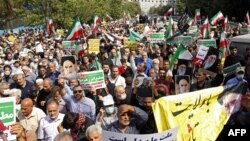Iran’s record of media repression and arrests is casting a chill over female journalists who want to report on mass protests.
Journalists inside Iran are “afraid of speaking openly,” Kiran Nazish, founding director of the Coalition for Women in Journalism, or CFWIJ, told VOA on Friday.
Nearly a dozen journalists — at least three of them women — have been detained over coverage of the protests and the death in custody of Mahsa Amini, 22, who was arrested by Iran’s morality police. Additionally, authorities have cut internet access as protests continue, according to rights groups and an Iranian diaspora news website.
Iranian state TV has said the death toll from violent clashes with security forces could be as high as 26, but it offered no further details. The Associated Press has reported the death toll at 11.
The CFWIJ said it was aware of at least three female journalists in custody: photojournalist Yalda Moaiery, who reported her own arrest on Instagram while covering protests in Tehran on Monday; Nilufar Hamidi, a reporter for Shargh Daily, who was reporting on Amini’s case; and Fatemeh Rajabi, a reporter in Tehran.
A female activist and her husband are also believed to be detained, the group said.
Authorities questioned Hamidi about her visits to the hospital where Amini was taken, and they confiscated her equipment, Nazish said via email.
Two brothers who work for the media outlet Mokrian — Masoud and Khosro Kordpour — were arrested Wednesday in Bukan, according to the English-language diaspora news website Iran Wire. It reported that authorities have warned newsrooms and journalists not to cover the protests.
The Committee to Protect Journalists (CPJ), which is also verifying reports of media arrests, documented Masoud Kordpour’s case among at least 11 others detained.
Freedom urged for detainees
CPJ Middle East program coordinator Sherif Mansour in a statement called on Tehran to free all those detained and to “restore the internet access that is vital to keep the public informed.”
Iran’s mission to the United Nations did not respond to VOA’s email requesting comment.
The CFWIJ said it had spoken with about a dozen journalists in Iran who fear repression. One of the journalists, whom Nazish did not identify because of security concerns, said she was in hiding at a friend’s house after hearing of arrests of those at protests.
“Some of these journalists have been arrested before, so this is not new for them. They are fully aware of the risk of covering the current protests,” said Nazish of CFWIJ via email. “One journalist has told us, their news channel has clear instructions to not report the ongoing protests.”
Iran has a dire media freedom record, ranking 178th out of 180 on the World Press Freedom Index, where 1 has the optimum conditions for journalism.
Media watchdog Reporters Without Borders, which compiles the index, describes Iran as “one of the most repressive [countries] for journalists,” with media nearly entirely under control of the regime.
For women in media, the risks can be great. The CWFIJ said it was aware of at least 17 female journalists currently detained across Iran, including those arrested over the protests.
“Iran is one of the most concerning countries, and indeed one of the most dangerous" for female journalists, Nazish said.
With protests spreading across Iran, access to internet is being blocked or slowed, along with text messages containing Amini’s name in Farsi, according to Keep it On, a coalition of digital rights groups who track internet blackouts.
The Associated Press cited the Iranian telecommunications minister as saying restrictions might be imposed “due to security issues.”
The internet shutdown is the third to be imposed on Iran in the past 12 months, according to digital rights group Access Now.
“People in Iran are angry, and blocking the internet won’t silence them,” Marwa Fatafta, a Middle East policy and advocacy manager at Access Now, said in a statement. “Instead of investigating the heinous death of Mahsa Amini, the Iranian regime is dialing up its repression — seeking to conceal its systematic human rights abuses against its own people.”
'Under the radar'
With journalists who covered the protests fearing arrest, several are “trying to stay under the radar,” said Nazish. Some are without passports or documents needed to be able to leave, a situation she said that leaves them "stuck between fear of repression and censorship.”
The U.S. issued an “Iran General License” on Friday to try to increase support for internet access in Iran by aligning sanctions guidance with advances in digital technology.
The step includes guidance for U.S. tech companies on offering Iranians “more options of secure, outside platforms and services,” according to a press release.
“We are taking this step against a stark backdrop. The Iranian government has cut off access to the internet for most of its 80 million citizens to prevent them— and the world — from watching its violent crackdown on peaceful protesters,” Secretary of State Antony Blinken said in a statement. “In the face of these steps, we are going to help make sure the Iranian people are not kept isolated and in the dark.”
Separately, the U.S. Treasury Department’s Office of Foreign Assets Control said Thursday that it would sanction members of Iran’s police and senior officials over the death of Amini and for the suppression of protesters and opposition voices.
“Mahsa Amini was a courageous woman whose death in morality police custody was yet another act of brutality by the Iranian regime’s security forces against its own people,” Treasury Secretary Janet Yellen said in a statement.
“We condemn this unconscionable act in the strongest terms and call on the Iranian government to end its violence against women and its ongoing violent crackdown on free expression and assembly,” the statement added.









